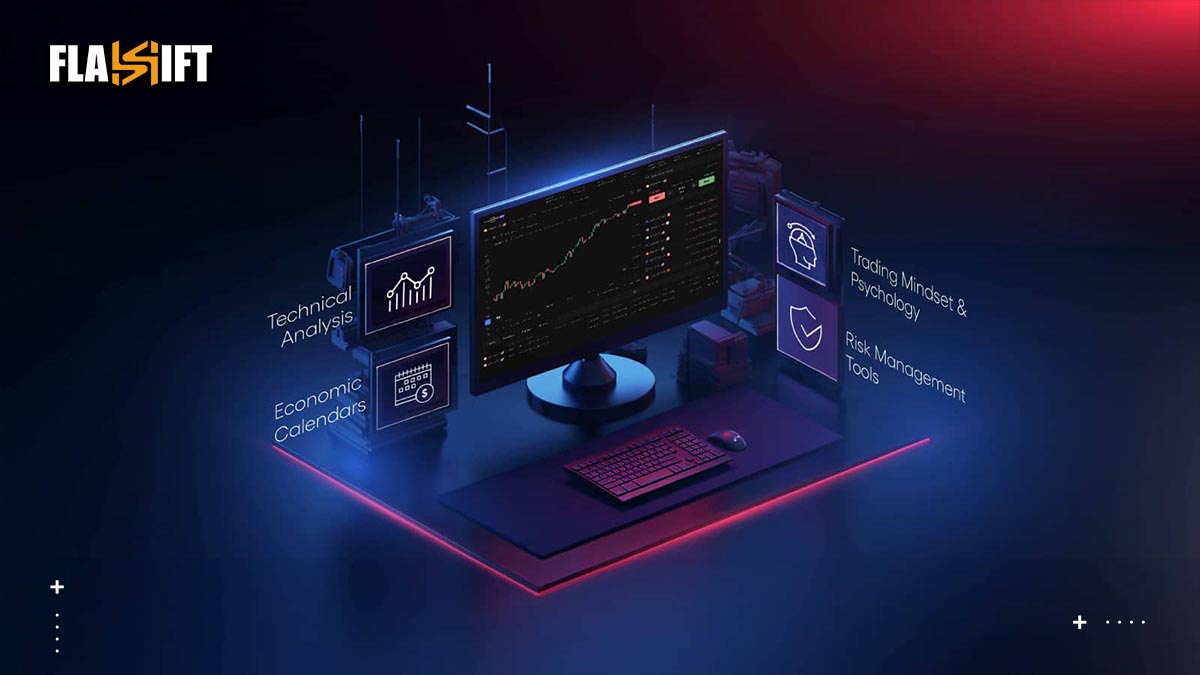If you’ve ever wished you could trade crypto with a larger account (without putting your own money on the line) crypto prop trading might be exactly what you’ve been looking for. It’s a growing space where trading firms give skilled traders access to capital and split the profits. You bring the talent; they bring the money.
In this guide, we’ll walk you through what crypto prop trading actually looks like behind the scenes, how these firms operate, what they look for in traders, and how you can get funded if you’ve got the skills. Let’s cut through the noise and get into the real stuff.
What Is Proprietary Trading in Crypto?
Proprietary trading in crypto, or “prop trading,” is basically trading with someone else’s money—but with your skills. Instead of risking your own capital, you trade with funds provided by a firm, and if you make profits, you get to keep a share of it. Think of it like this: you do the work, they give you the firepower.
These firms aren’t doing this out of generosity. They’re looking for traders who can consistently perform. You usually have to pass a challenge or some kind of evaluation to prove you’re not just lucky or reckless. Once you’re in, they give you access to a real account, and you focus on trading while they handle the backend, risk parameters, and scaling.
In the world of crypto, where markets move fast and opportunities pop up around the clock, prop trading gives independent traders a real shot at going big without the stress of putting everything they own on the line.
How Do Crypto Prop Firms Work?

Crypto Prop Trading is built on a simple principle: skilled traders get access to large amounts of capital from a firm, and profits are shared. You don’t have to put your own money at risk—the firm takes on the financial risk, and you focus on performance.
Unlike traditional trading, where you fund your own account, crypto prop firms give you the chance to grow faster by leveraging their money. But they don’t just hand it out—you’ll need to prove your skills first.
The Evaluation Phase
Before you can trade real capital, you typically need to pass an evaluation or “challenge.” This is where you show the firm you can trade profitably and manage risk.
What’s usually involved:
- A demo account with simulated funds (e.g. $25,000 or $100,000)
- A profit target (often 5%–10%) within a set number of days
- A maximum drawdown or daily loss limit
- Rules about leverage, trading style, or holding over weekends
This stage filters out reckless or inconsistent traders. If you pass, you move on to the funded stage.
Getting Funded: Live Capital & Profit Sharing
Once you pass the challenge, the firm gives you access to a funded account. Now, you’re trading real money—just not yours.
What to expect at this stage:
- You earn a share of the profits, typically 50%–90%
- The firm absorbs any losses (as long as you follow their rules)
- Some firms scale you up to larger accounts over time
At this point, Crypto Prop Trading becomes a serious income opportunity—especially if you’re consistent.
Tools and Support from the Firm
Good crypto prop firms don’t just give you capital; they also provide tools and support to help you succeed.
You may get:
- Access to professional platforms like TradingView or MT5
- Performance dashboards to track your stats
- Risk management systems to prevent major losses
- Community forums, mentors, or webinars
Not all firms offer the same level of resources, so it’s worth comparing them before signing up.
The Bottom Line
Crypto Prop Trading is changing the way independent traders scale in the crypto space. You don’t need deep pockets—just skill, discipline, and a strategy that works. If you can prove yourself, you can trade large accounts and share in the profits, without risking your own capital. It’s performance-based, transparent, and growing fast.
Best Crypto Prop Trading Platforms in 2025 (Top 3)
Breakout (Breakout Prop)
Breakout came on the scene in 2022 and has quickly built a strong following in the crypto trading community. It’s a crypto-native prop firm that lets you trade real markets using real capital—no demo fluff, no simulated environments. You get access to up to $200K in funding, and everything runs through major exchanges like Binance Futures. No hidden restrictions, no time limits, and you keep up to 95% of the profits if you’re consistent.
One of the biggest reasons traders like Breakout is how fast they pay. Once you’re funded, payouts hit your crypto wallet—sometimes the same day. It’s clean, it’s efficient, and it feels like it’s built by actual traders, not some corporate team trying to cash in on the prop boom.
Breakout doesn’t try to trap you with unrealistic rules. You’re given clear risk limits, you trade when and how you want, and the focus stays on performance. If you’re a serious crypto trader who wants capital without the nonsense, Breakout is about as straightforward as it gets.
FundedNext (Stellar)
FundedNext is one of the big names in the prop world—and for good reason. It’s been around since 2022, and while it’s not crypto-exclusive, its crypto offering is solid. You can start with a $300K account and scale up from there if you perform. It’s run through platforms like MetaTrader and cTrader, which means you’re trading crypto via CFDs—not directly on exchange—but for most traders, it works fine.
Payouts are fast. They say 24 hours, but a lot of people report getting their money in under six. Rules are clear, and there’s no deadline for hitting targets, which takes a lot of pressure off. Profit split starts at 80% and can climb to 95% over time.
FundedNext isn’t trying to be the most innovative, but it’s consistent. You know what you’re getting: big capital, fast withdrawals, and no tricks. If you want structure, scale, and reliability, it delivers.
HyroTrader
HyroTrader is newer, launched in 2023, but it’s already turning heads, especially among hardcore crypto traders. What sets it apart is that it connects directly to Bybit and Binance via API, so you’re trading in real markets, not on synthetic platforms. That alone puts it ahead of most crypto prop firms when it comes to authenticity.
You can start small, but their scaling goes up to $1 million, which is aggressive. Profit splits range from 70% to 90%, depending on performance. The evaluation isn’t easy, and the fee isn’t cheap—but if you pass, they refund it with your first withdrawal. Payouts are quick too—usually same day.
There’s no pressure to rush through the challenge. You can take your time, trade 24/7, and work within clear, simple rules. If you’re confident in your edge and want to trade with size in a real market setting, HyroTrader is worth a serious look.
Comparison Table
| Feature | Breakout | FundedNext (Stellar) | HyroTrader |
| Founded | 2022 | 2022 | 2023 |
| Trading Environment | Real crypto trading on Binance Futures | CFD trading via MT4 / cTrader | Real exchange trading via Bybit/Binance APIs |
| Max Initial Funding | $200,000 | $300,000 (scalable to $4M) | $1,000,000 scaling potential |
| Profit Split | 80%–95% | 80%–95% | 70%–90% |
| Evaluation Time Limit | No time limit | No time limit | No time limit |
| Payout Speed | Daily payouts, usually <24h | Within 24 hours (often under 6h) | Same-day payouts |
| Challenge Fee Refund | No upfront deposit or loss liability | Not refundable if failed | Refunded upon first withdrawal if passed |
| Real Crypto or Simulated? | Real trading, not simulated | CFD/simulated (not actual exchange) | Real-time execution on real exchanges |
| Trustpilot Rating (2025) | ★ 4.9 / 5 | ★ 4.6 / 5 | ★ 4.4 / 5 |
| Known For | Transparency, wallet payouts, clean rules | Large firm, fast payouts, all-asset support | Real exchange access, high scaling cap |
| Best For | Traders who want a crypto-native setup | Traders who want scale, structure, and variety | Advanced crypto traders wanting realism |
Steps to Get Funded by a Prop Firm

-
Pick a firm that actually fits your style
Don’t just chase the highest profit split or biggest funding. Look at how the firm operates. Are they using real exchanges or just simulated trades? Do they pay out fast, or do people complain about delays? Go through their rules — if you can’t find them clearly explained, that’s already a red flag. Choose a firm that aligns with how you trade and what kind of risk you’re comfortable with.
-
Sign up and choose your challenge
Every prop firm runs on evaluations. You’ll pick a challenge (usually based on account size). The more funding you go for, the higher the entry fee and the tougher the risk limits. Most firms offer something like a $25K, $50K, or $100K evaluation. You’ll pay a one-time fee, and that’s your shot. Some firms refund the fee if you pass, others don’t.
-
Trade — but within their rules
This is where most traders mess up. You’re not just trying to hit a profit target, you’re showing that you can follow rules and manage risk. That means:
- Don’t blow your daily or total drawdown
- Don’t overleverage
- Stick to whatever their rules are (like not trading during major news events, if that’s a thing for them)
Even if you hit the profit target, breaking a rule usually disqualifies you.
-
Pass the challenge and get verified
Once you complete the challenge within their guidelines, they’ll review your trades. Some firms do this fast (like within a few hours) others take a couple days. If you passed cleanly, they’ll move you forward to the funding stage.
At this point, you’ll probably need to verify your identity with KYC. Standard stuff.
-
Get funded and start trading with real capital
Now you’re trading a live account. Your job is simple: follow the rules, stay consistent, and grow the account. Most firms will split profits with you weekly or monthly — some even daily. If you lose too much or break a rule, they’ll usually pull the plug. But if you stay steady, you’re in.
-
Scale up if you’re good
If you consistently hit profits without violating limits, many firms will scale your account — sometimes automatically, sometimes after you request it. That’s where things get interesting: more capital, higher payout percentages, and a chance to build something real.
That’s it. No shortcuts. You prove you can trade, they give you capital. Simple, but not easy. And the best part? You’re not risking your own money. Just your skill and discipline.
Pros and Cons of Prop Trading for Crypto Traders
Crypto prop trading has opened a new path for traders who have the skill but not the capital. It’s appealing; trade someone else’s money, keep most of the profits, and skip the stress of risking your own savings. But like anything in trading, it’s not all upside. There are trade-offs, rules, and realities that you won’t see in the marketing headlines.
Here’s what you’re really getting into — the ups, the downs, and everything in between.
Pros
- You Get to Trade with Real Capital (Without Having It)
Let’s face it. Most traders don’t have $50K sitting around to deploy. With a prop firm, you can trade large positions without fronting the money yourself. That’s a big deal. It allows you to run strategies at size and scale your edge faster than you ever could on a small personal account.
- You Don’t Risk Your Own Money
This one is huge. Blow up? You lose the account, not your rent money. It removes the emotional baggage that comes with trading your own funds. You can focus on process over panic.
- Built-in Structure Forces You to Stay Disciplined
Crypto Prop firms have rules: max drawdowns, position sizing, risk per trade. Annoying? Maybe. Helpful? Definitely. Those rules often do for traders what they can’t do for themselves — enforce discipline. And that structure often leads to better habits, even if you eventually go solo again.
- Profit Split Can Be Worth It
Yeah, the firm takes a cut. But if you’re trading with $100K and keeping 80%, you’re still pocketing more than if you were grinding $5K of your own. You don’t have to grow capital from scratch, you just have to perform.
- Some Firms Actually Teach You Stuff
Not every firm is a cash grab. Some offer mentorship, trading psychology resources, trade breakdowns, even one-on-one feedback. For newer traders or even experienced ones who want to level up, this kind of access is hard to find anywhere else.
Cons
- The Rules Can Kill You
Most prop firms have rigid rules. Hit a daily loss limit? You’re out. Trade during news when it’s restricted? Account gone. Sometimes it feels like the rules are set to make you fail and, in some cases, they kind of are.
- The Evaluation is a Mind Game
Before you even touch real money, you’ve got to pass a challenge. Usually, you need to hit a profit target while avoiding major drawdown. Sounds simple but it’s not. Traders often break under the pressure of having to “prove” themselves on a timeline.
- Payouts Aren’t Always Straightforward
Some firms make you wait 30 days for your first withdrawal. Others require a minimum number of trading days before you can get paid. It’s not always a scam, but it can be frustrating if you need liquidity or fast access to profits.
- You’re Stuck in Their Box
Many prop firms restrict what you can trade, how you can trade it, or even what platforms you’re allowed to use. If you’re a DEX-native or trade altcoins with tight setups, you might find their system doesn’t match your style.
- Not All Firms Are Legit
Let’s be real. There are scams out there. Some firms move the goalposts mid-challenge, stall payouts, or close accounts for questionable reasons. If the offer sounds too good to be true (100% profit split, no risk, instant funding), it is scam probably.
Last Words…
Crypto prop trading isn’t some magical shortcut to getting rich. But if you’re consistent, know your edge, and can stay within the lines, it can be a solid way to grow without risking your own stack. Just read the fine print, test your strategy under their rules, and don’t fall for flashy promises. There’s real opportunity here if you treat it like a business.
FAQ
- Can I get funded if I only trade altcoins, not Bitcoin?
Yes. Many crypto prop firms support a wide range of altcoins—especially those listed on major exchanges like Binance or Bybit. Just check the asset list before applying.
- What happens if I break a rule after getting funded?
Your account is usually terminated immediately, and you lose access to future funding. Most firms are strict on rule violations, even small ones.
- Do prop firms actually use real money, or is it just numbers on a screen?
It depends on the firm. Some use real capital on actual exchanges (like Breakout or HyroTrader), while others simulate trades using internal platforms. Always read the fine print.
- Is there any risk to my personal crypto if I join a prop firm?
No, as long as the firm doesn’t require a deposit or wallet connection. Stick with firms that don’t ask you to fund anything upfront (except for challenge fee).
- Can I automate my trading with bots or scripts?
Some firms allow algorithmic trading via APIs (especially those using live exchanges). Others ban it outright. You need to check the rules before trying it.
- How long does it really take to get paid once I’m funded?
With good firms, payouts happen in 1–3 days—sometimes within hours. If a firm delays or makes excuses, that’s a red flag. Look for proof from real traders.







